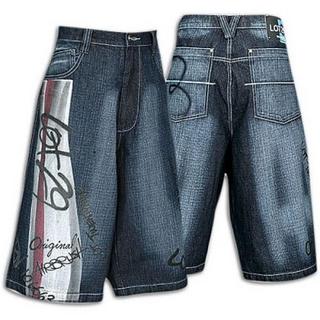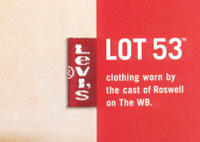TTAB Finds "LOT29" Confusingly Similar to "LOT 53" for Clothing
Because LOT29 is a lot like LOT 53, the Board affirmed the PTO's Section 2(d) refusal to register LOT29 for jeans, shorts and other clothing items, finding the mark likely to cause confusion with LOT 53, registered for the same and other items. In re Wicked Fashions, Inc., Serial No. 78145261 (August 12, 2005) [not citable].
 Since the goods are identical in part, the degree of similarity between the marks necessary to support a finding of likely confusion decreases. The key issue, then, was whether the marks, when compared in their entireties, are similar in appearance, sound, connotation, and commercial impression.
Since the goods are identical in part, the degree of similarity between the marks necessary to support a finding of likely confusion decreases. The key issue, then, was whether the marks, when compared in their entireties, are similar in appearance, sound, connotation, and commercial impression.As to appearance, the Board found that the points of similarity outweigh the points of dissimilarity. Likewise the marks are similar in sound: the word “lot” followed by numerical portions having three syllables. Wicked Fashions contended that “some may view LOT29 as an alphaneumeric string" spoken as "EL-OH-TEE-TWENTY-NINE." The Board noted once again that there is no correct pronunciation of a trademark "because it is impossible to predict how the public will pronounce a mark. However, the Board found it unlikely that purchasers would pronounce the mark as suggested by Applicant:
"'Lot' is an English language word. When a series of letters spells out an English word, consumers will likely read the word, rather than sound out each letter in the word, even if the letters are followed by a numeral."
The connotations of the marks are "highly similar." The word "lot" is defined as "miscellaneous articles sold as a unit." Thus, "[b]oth marks convey to consumers that the goods belong to or come from a numbered 'lot.'"

With regard to commercial impression, the Board provided no separate discussion, instead concluding that in view of the similarities in appearance, sound, and connotation, the marks are similar in overall commercial impression.
Wicked argued that the word "lot" is "suggestive of clothing," that the numerical portions of the marks would be the dominant portions, and that the marks are readily distinguishable. [After all, 29 does not equal 53]. The Board, however, did not believe that consumers would ascribe any particular significance to "lot" or "even to the mark taken as a whole." Moreover, "the first part of a mark is more likely to be impressed upon the mind of a purchaser and remembered." Thus the Board did not agree that the numerical portions dominate the marks.
TTABlog comment: Note how the Board glossed over "commercial impression" as a factor when comparing the marks. I don't understand why "commercial impression" should be a separate factor anyway. It seems to me that the test should be whether the marks are similar in overall commercial impression, taking into account their appearance, sound, and meaning.
This issue of whether "commercial impression" is a separate factor or the overall test came up in the CAFC's VEUVE CLICQUOT decision earlier this year. Palm Bay Imports, Inc. v. Veuve Clicquot Ponsardin Maison Fondee En 1772, 73 USPQ2d 1689 (Fed. Cir. 2005). There, the CAFC noted that the Board had made a "minor misstatement" regarding the test for similarity "in an otherwise proper analysis," because the Board treated "commercial impression" as the ultimate conclusion, rather than as a separate factor to be considered with appearance, sound, and meaning. But the appellate court found that misstatement not to be reversible error, noting that its own precedent "counsels that the phrase 'commercial impression' is occasionally used as a proxy for the ultimate conclusion of similarity of dissimilarity of marks resulting from a comparison of their sound, appearance and meaning."
So the bottom line is that it doesn't seem to make a lot of difference anyway.
Text Copyright John L. Welch 2005




0 Comments:
Post a Comment
<< Home